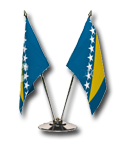

Vijesti
Surviving the Bosnian Genocide The Women of Srebrenica Speak, By: Selma Leydesdorff
Surviving the Bosnian Genocide The Women of Srebrenica Speak, By: Selma Leydesdorff |
|
In July 1995, the Army of the Serbian Republic killed some 8,000 Bosnian men and boys in and around the town of Srebrenica—the largest mass murder in Europe since World War II. Surviving the Bosnian Genocide is based on the testimonies of 60 female survivors of the massacre who were interviewed by Dutch historian Selma Leydesdorff. The women, many of whom still live in refugee camps, talk about their lives before the Bosnian war, the events of the massacre, and the ways they have tried to cope with their fate. Drawing on their memories, though fragmented by trauma, the women tell of life and survival under extreme conditions, while recalling a time before the war when Muslims, Croats, and Serbs lived together peaceably. By giving them a voice, this book looks beyond the rapes, murders, and atrocities of that dark time to show the agency of these women during and after the war and their fight to uncover the truth of what happened at Srebrenica and why. |
Excerpt from Surviving the Bosnian Genocide: The Women of Srebrenica Speak
Here’s the story of a woman named Muska, excerpted from Selma Leydesdorff’s new book, Surviving the Bosnian Genocide: The Women of Srebrenica Speak.
And then the time comes when you have to leave as well. We were the last. The last day, Thursday evening, or maybe it was afternoon, we were told, “Make sure you don’t have anything sharp with you, not even manicure scissors. Sharp objects are not allowed. They are regarded as dangerous.” We were also instructed that they took young women and girls, so we rubbed ourselves with ashes. You wore the ugliest clothes you had and made yourself as unattractive and inconspicuous as possible. We were put in a truck, and you know, on the way there; on one side are the Dutch soldiers and on the other the Serbs. The Dutch soldiers [who were sent by the U.N. as peacekeepers] just stood there looking at us and let us go by. They said nothing; they were also scared. I still remember that one soldier from the military cried when we had to leave. He said he would never forget the faces, that he saw the people taken away and he was part of what happened … I saw he was deeply disappointed with the whole operation. At one point he began to curse — “Karremans’ cancer pit” [Karremans was the DutchBat commander] and “they’re useless, they have no guts” — as a kind of apology. And they started to cry, the men really began to cry loudly. They were bawling, not just sniffling. When we had to leave, they tried to put us at ease by saying that maybe we would come out okay. You also saw women whose children were taken away, even though they were only 12 or 13 years old.
A woman who walked behind me had a little boy, a son. He was skinny and tall for his age, but had a child’s face. Good Lord, you could see he was a child. They told him, “You have to go over there and your mother over here.” She went up to the Serb soldier … and latched onto him with her whole body. “Then you take me as well; if you take him, then you take me too! He’s 12 years old!” She was screaming and yelling … He couldn’t get her off himself. So he said, “No, they’re being taken another way.” She said, “No … you’re going to murder them, you’re murdering them. I know it, I know it! So just say it!” So many traumatic happenings right before your eyes — some said they wanted to die, that they didn’t want to know what happened to their children. That’s how it was. They screamed, they were pulled off and taken to the truck. That woman was thrown in the truck, and the others were told it was their job to make sure she didn’t get out of the truck. Otherwise, she really wouldn’t come back. So what do you do to prevent something worse? You grab hold of the woman and put her down — and we sat on her … From the bus, we saw a large field full of men. The first thing I noticed was how many men there were. I didn’t know so many men had gone to the base. You saw that the life had already gone out of them. Their eyes were empty. They knew they were looking at death, and you could see it in their eyes.
Selma Leydesdorff is professor of Oral History and Culture at the University of Amsterdam. She has been working over the years in fields mostly related to trauma. After her work on the Jewish poor of Amsterdam she was participant in several international projects on the Holocaust, She is a well known writer on women’s history. After 2000 she turned her attention to the survivors of Srebrenica and traveled to Bosnia for many years. Her work was met with hostility from the Dutch government that tried to hide the role of the Dutch soldiers during the fall. Her book on the survivors (forthcoming at Indiana University Press) was praised by many, and immediately translated into Bosnian. At the moment Selma Leydesdorff is interviewing people around the Demjanjuk / Sobibor case. She has served on many editorials and is at present one of the editors of the series Memory and Narratives.
Surviving the Bosnian Genocide The Women of Srebrenica Speak, By: Selma Leydesdorff |
Vijesti: